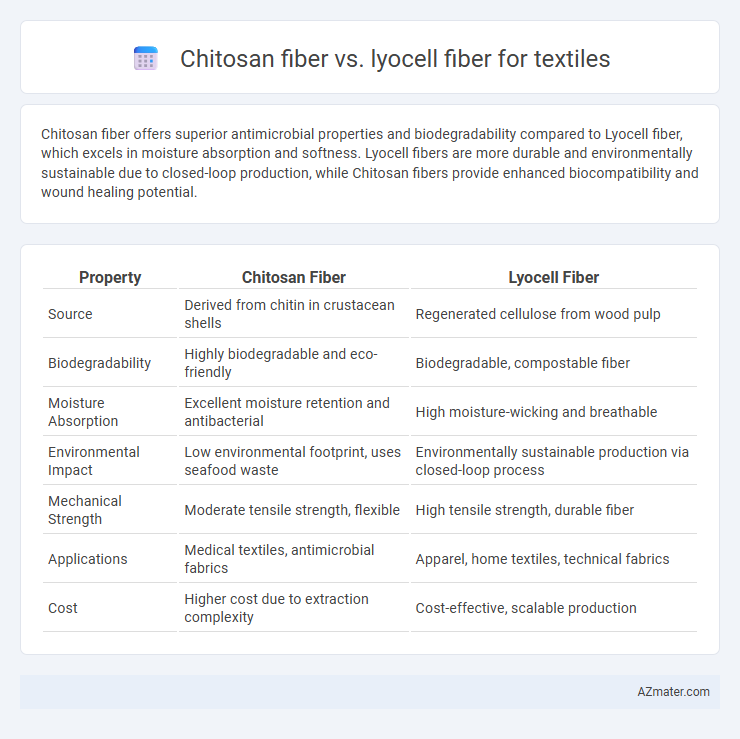Chitosan fiber offers superior antimicrobial properties and biodegradability compared to Lyocell fiber, which excels in moisture absorption and softness. Lyocell fibers are more durable and environmentally sustainable due to closed-loop production, while Chitosan fibers provide enhanced biocompatibility and wound healing potential.
Table of Comparison
| Property | Chitosan Fiber | Lyocell Fiber |
|---|---|---|
| Source | Derived from chitin in crustacean shells | Regenerated cellulose from wood pulp |
| Biodegradability | Highly biodegradable and eco-friendly | Biodegradable, compostable fiber |
| Moisture Absorption | Excellent moisture retention and antibacterial | High moisture-wicking and breathable |
| Environmental Impact | Low environmental footprint, uses seafood waste | Environmentally sustainable production via closed-loop process |
| Mechanical Strength | Moderate tensile strength, flexible | High tensile strength, durable fiber |
| Applications | Medical textiles, antimicrobial fabrics | Apparel, home textiles, technical fabrics |
| Cost | Higher cost due to extraction complexity | Cost-effective, scalable production |
Introduction to Chitosan and Lyocell Fibers
Chitosan fiber, derived from chitin in crustacean shells, offers natural antimicrobial, biodegradable, and moisture-retentive properties, making it a sustainable choice in textile applications. Lyocell fiber, produced from wood pulp via a closed-loop solvent spinning process, is known for its high strength, softness, and eco-friendly production. Both fibers provide unique benefits in textiles, with chitosan excelling in bio-functionality and lyocell in comfort and environmental sustainability.
Raw Material Sources and Sustainability
Chitosan fiber is derived from chitin found in crustacean shells, providing a renewable, biodegradable source that utilizes seafood industry waste, enhancing circular economy efforts. Lyocell fiber is produced from sustainably sourced wood pulp, primarily eucalyptus, via a closed-loop solvent spinning process that recycles water and solvents to minimize environmental impact. Both fibers offer eco-friendly alternatives to synthetic textiles, but chitosan excels in biodegradability and antimicrobial properties, while lyocell provides superior softness and moisture management.
Manufacturing Processes Compared
Chitosan fiber manufacturing involves the extraction of chitosan from crustacean shells followed by wet spinning, which requires precise control of pH and temperature to form fibers with antimicrobial properties. Lyocell fiber is produced through a closed-loop solvent spinning process using non-toxic N-Methylmorpholine N-oxide (NMMO) to dissolve cellulose, emphasizing environmental sustainability and fiber strength. The key manufacturing difference lies in Chitosan's bio-based extraction and wet spinning, while Lyocell utilizes advanced solvent spinning for eco-friendly mass production.
Fiber Structure and Chemical Composition
Chitosan fiber, derived from chitin in crustacean shells, features a porous structure with amino and hydroxyl groups that provide antimicrobial properties and enhanced moisture absorption. Lyocell fiber, produced from regenerated cellulose through a solvent spinning process, possesses a smooth, uniform fibrillar structure rich in glucose units linked by b-1,4-glycosidic bonds. The chemical composition of chitosan includes deacetylated polysaccharides with reactive amino groups, whereas lyocell is purely cellulose-based, contributing to its biodegradability and strength in textile applications.
Environmental Impact Assessment
Chitosan fiber, derived from chitin found in crustacean shells, offers significant biodegradability and antimicrobial properties, reducing environmental pollution and textile waste. Lyocell fiber, produced from sustainably sourced wood pulp via a closed-loop solvent spinning process, minimizes chemical emissions and water usage compared to conventional fibers. Both fibers contribute to eco-friendly textiles, but chitosan's biodegradability and waste valorization provide a distinct advantage in lowering the environmental footprint.
Mechanical and Physical Properties
Chitosan fiber exhibits superior antibacterial properties and biodegradability, with moderate tensile strength and elasticity suitable for specialized textile applications. Lyocell fiber offers excellent mechanical strength, high moisture absorbency, and smooth surface texture, enhancing comfort and durability in apparel. The physical resilience and biodegradability of Chitosan fiber contrast with the higher tensile strength and moisture management capabilities of Lyocell, influencing their suitability for different textile uses.
Biodegradability and End-of-Life Options
Chitosan fiber, derived from chitin in crustacean shells, offers excellent biodegradability due to its natural polysaccharide structure, breaking down efficiently in soil and water environments. Lyocell fiber, made from sustainably sourced wood pulp through a closed-loop process, also demonstrates high biodegradability but decomposes more slowly compared to chitosan fiber. Both fibers provide environmentally friendly end-of-life options, with chitosan excelling in rapid biodegradation and lyocell supporting compostability and recycling within textile waste management systems.
Textile Applications and Market Trends
Chitosan fiber exhibits strong antimicrobial properties and biodegradability, making it highly suitable for medical textiles, activewear, and eco-friendly fabric markets. Lyocell fiber, known for its softness, moisture-wicking ability, and sustainability, dominates in apparel, home textiles, and technical fabrics with growing demand driven by consumer preferences for eco-conscious products. Market trends highlight increasing investments in bio-based fibers, with Chitosan gaining traction in niche functional textiles while Lyocell expands in mainstream sustainable fashion applications.
Consumer Safety and Allergenicity
Chitosan fiber exhibits natural antibacterial and antifungal properties, significantly reducing the risk of skin irritation and allergic reactions, making it highly suitable for sensitive skin textile applications. Lyocell fiber, derived from cellulose, is hypoallergenic and breathable but may retain chemical residues from processing, posing minimal allergenicity concerns for most consumers. Both fibers support consumer safety, with chitosan offering enhanced antimicrobial benefits and lyocell providing gentle comfort with low allergenic potential.
Future Outlook and Innovation Potential
Chitosan fiber, derived from chitin found in crustacean shells, offers promising biodegradability and antimicrobial properties, positioning it as a sustainable alternative in textile innovation. Lyocell fiber, produced through eco-friendly solvent spinning of cellulose, is already well-established for its environmental benefits and high-performance characteristics, with ongoing advancements in recycling and fiber blending technologies. Future developments in chitosan fiber focus on enhancing mechanical strength and cost-efficiency, while lyocell innovation aims to expand its functional applications through nanotechnology and bio-based chemical treatments.

Infographic: Chitosan fiber vs Lyocell fiber for Textile
 azmater.com
azmater.com